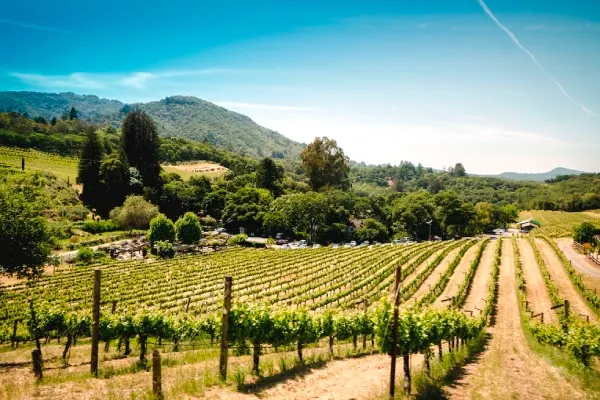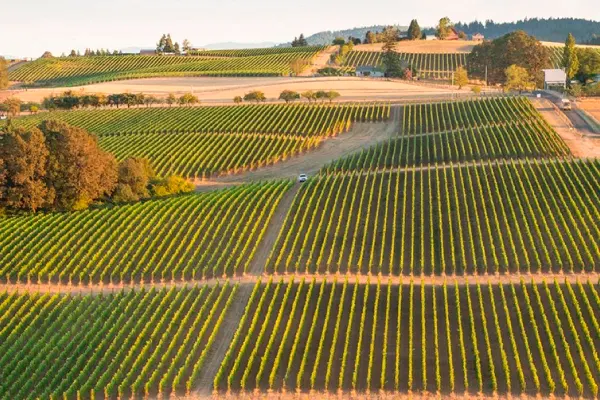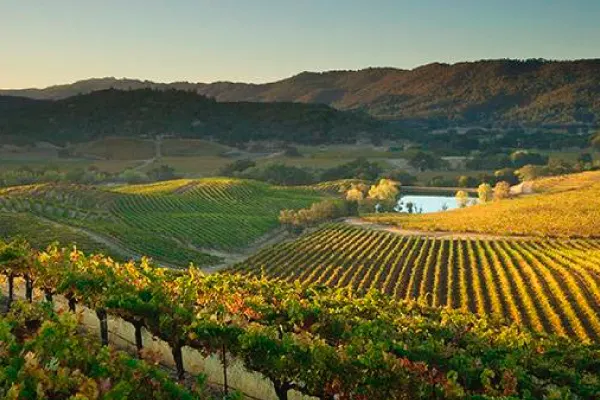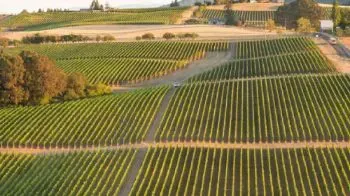The United States produces some of the best red and white wines in the world, such as Caymus, Stag's Leap, Laurel Glen, Opus One and Château Montelena. Although the United States is one of the great countries of the New World, not all regions of the country have favorable climates and soils for growing vines; the most important wine regions in the United States are located on the Pacific Coast alone.

Image: Benziger Family Winery
United States of America
The history of wine in this country is very old. In the beginning, the wines were made with common, American grapes, which created very simple and not very tasty wines. From 1619 onwards, new grapes began to appear from winemakers in Europe, with the aim of producing wines with the same quality as the French. However, the results were mediocre as they crossed European grapes with native grapes.
The planting of vines in California with the Missión grape was started by Franciscan missionaries in San Diego but the results were of poor quality. At the same time, a sparkling wine with the Catawba grape was also produced in Ohio.
The enforcement of Prohibition delayed the improvement of American wine, only resuming in 1935, with the production of table grapes, but these only managed to create cheap smooth wines. Consequently, to try to improve the quality of wines, several university surveys tried to identify which varieties were best suited to each region, seminars and oenology courses were held, and American wine grew in quality and volume.
Although wine culture is not widespread in the country, its population of over 300 million inhabitants makes the United States one of the largest consumers in the world.

Image: Cristom Vineyards
United States’ Terroir
The USA is geographically very well located, but most of the territory does not have a good vocation for wine production due to climatic conditions. Only on the West Coast, in the states of Washington, Oregon and California, are there favorable conditions for planting vines.
Despite this, today wine is produced in the 50 states of the country, making it the fourth largest producer in the world, after France, Italy and Spain. The total number of vines planted is 4,500km2. The state of California has a number of microclimates, but in all areas of the state there is a lack of rain during the grape ripening season. This means that all areas have drip or sprinkler systems for water in the vineyards. The climate in this state is typically Mediterranean, with fresh winds, lots of sun and well-placed rain.
The great ocean currents coming from the Pacific Ocean exert a great influence on the climate. During the mornings, there is a cool breeze and cold fog, which not only create thermal amplitude, but also a necessary humidity for the maintenance of the vines. In areas where this phenomenon does not occur, temperatures reach 40ºC in summer.
United States Wine Regions
- California: it is the largest wine producer in the country and its viniculture dates back to the mid-19th century. Its territory is a succession of small valleys, each with its particular climate and soil, creating a junction of terroirs suitable for the development of quality wines. California's most important regions are Napa Valley and Sonoma Valley, followed by Mendoncino and Lake Counties.
- Napa Valley: region known worldwide for the quality of its wines. It has more than 500 wineries, making it the densest wine region in the world.
- Sonoma Valley: region marked by its wide plains and gentle hills. The climate in this region is cooler than that of Napa Valley and benefits from sea breezes and fog. It has more than 300 wineries.
- Oregon: is located in northern California, at a latitude where temperatures are slightly cooler. The most planted varieties in this region are: Pinot Noir, Pinot Gris, Riesling and Chardonnay.
- Washington: the state of Washington (not to be confused with the capital) has the same latitude as the French regions Bordeaux and Burgundy. Being located on the coast gives it lower temperatures and more hours of sunshine than California. The main varieties of this region are: Merlot, Cabernet Sauvignon, Cabernet Franc, Sangiovese, Riesling, Chardonnay, Semillon and Sauvignon Blanc.

Image: Vacations Made Easy
Types of wine from the United States of America
California produces rich, full-bodied red wines, typically made from the Zinfandel variety, which is recognized worldwide as "the California grape". These wines have intense red fruit flavors and a high alcohol content, usually with little residual sugar.
Zinfandel reds are wines very well vinified, rich, full-bodied, powerful and with toasted notes of French oak from first-use barrels.
Cabernet Sauvignon reds from Napa and Sonoma Valley are smooth and fruity, with few tannins and hints of black fruit.
Merlots produced in Monterey and regions of the North Coast of the state, especially Napa Valley, are wines with deep color, silky tannins, good body and notes of plums and black fruits.
The classic California Chardonnay is quite full-bodied - almost liqueur -, with a high alcohol content, low acidity and presents notes of toast, almonds and butter, along with exotic flavors of peaches and bananas.
The United States grape varieties
California produces wines mainly from the following red varieties: Cabernet Sauvignon, Merlot and Zinfandel, but lately Syrah and Cabernet Franc have also grown.
In the Central Valley (Napa Valley and Sonoma Valley) it is more common to see blends of Colombard, Chenin Blanc, Thompson Seedless, Carignan, Ruby Cabernet and Barbera. They are wines produced to meet the great demand of the North American domestic market, usually sold under the popular name of "two buck chuck".
In addition to these main varieties, other varieties have been planted, such as Mondeuse, Viognier, Marsanne and Pinot Noir.
 Portugal
Portugal Spain
Spain France
France Germany
Germany United Kingdom
United Kingdom Monaco
Monaco



